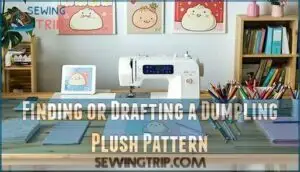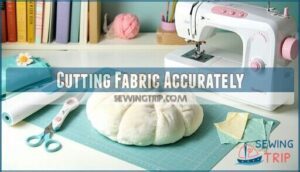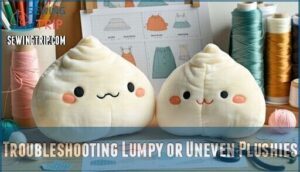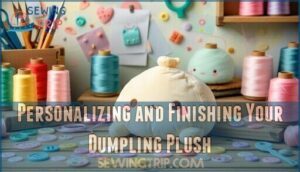This site is supported by our readers. We may earn a commission, at no cost to you, if you purchase through links.
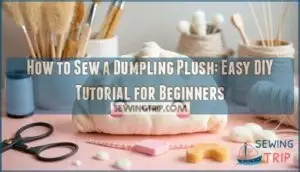 Learning how to sew a dumpling plush is easier than you’d think! Start with soft fabric like fleece or minky, then cut two circles for the body. You’ll need polyester stuffing, sharp scissors, and thread.
Learning how to sew a dumpling plush is easier than you’d think! Start with soft fabric like fleece or minky, then cut two circles for the body. You’ll need polyester stuffing, sharp scissors, and thread.
Sew the pieces together, leaving a small opening for stuffing. Fill it evenly to avoid lumps—this step takes patience but makes all the difference. Close the opening with careful stitches.
The real magic happens when you create those signature dumpling pleats on top by gathering fabric and securing it. Add a kawaii face if you’re feeling creative! The secret lies in mastering the pleating technique and choosing the right fabric density.
Table Of Contents
Key Takeaways
- Choose the right fabric – You’ll want soft, durable materials like fleece, minky, or cotton that handle stuffing well and won’t split at the seams when you’re sewing your dumpling together.
- Master the signature pleated top – You’ll create authentic dumpling charm by cutting a larger circle, using running stitches around the edge, then gently pulling to gather the fabric into natural-looking pleats.
- Stuff gradually for perfect shape – You’ll avoid lumpy results by working from the bottom up with small handfuls of poly-fil, pushing stuffing into corners first and distributing it evenly throughout the plush.
- Reinforce stress points for durability – You’ll ensure your dumpling lasts through countless cuddles by double-stitching where the crumpled top meets the body using strong polyester thread.
What Materials Do You Need for a Dumpling Plush?
Before you start stitching your adorable dumpling plush, you’ll need to gather a few simple materials that’ll make this project a breeze.
Don’t worry if you’re not sure what works best – we’ll walk through everything from choosing the perfect cuddly fabric to picking stuffing that won’t leave your dumpling looking like it skipped leg day!
Best Fabrics for Plushies
Your fabric choice makes or breaks your kawaii dumpling plushies! You’ll want something that’s both cuddly and durable for your sewing adventure.
Here are the top fabric types for plushie making:
- Minky fabric – The highest quality with ultra-soft texture and professional finish
- Fleece benefits include beginner-friendly stretch and forgiving sewing mistakes
- Cotton blends offer breathability but need extra stuffing for plump shapes
Felt works great for details, while sewing textures like faux fur add personality to your creation. When selecting fabrics, consider the plush toy materials to guarantee the best results for your project.
Choosing Stuffing and Batting
When stuffing your kawaii dumpling plushies, polyester fiber beats cotton balls hands down. It’s lightweight, washable, and won’t clump like cotton.
For felt sewing projects, consider fabric density when choosing filling materials. The use of polyester fiberfill products can greatly improve the overall quality of your plushies.
| Stuffing Type | Best For |
|---|---|
| Polyester Fiber | Most plushie making projects |
| Poly-fil Batting | Extra fluffy dumplings |
| Micro Beads | Weighted, squishy texture |
| Wool Stuffing | Natural, breathable option |
Choose high thread count materials for durability.
Tools and Supplies Checklist
Successfully gathering your sewing arsenal makes all the difference in plushie making. You’ll need essential sewing notions and fabric tools to bring your dumpling to life.
- Needle selection: Universal or denim needles for multiple fabric layers
- Thread types: Polyester thread for durability and strength
- Sewing machines: Optional but speeds up seam construction
Sharp fabric scissors and pins complete your toolkit for felt sewing success.
Understanding fabric safety standards is vital for creating a safe and enjoyable plushie.
Safe Materials for Children’s Toys
When sewing for little ones, prioritize their safety by choosing Toxic Free Fabrics and Eco Friendly Dyes that meet Child Safety Standards. Look for OEKO-TEX certified materials and Non Toxic Fillings like organic cotton batting. Hypoallergenic Materials prevent skin irritation.
Your local Sewing Community can guide you toward safe Fabric Selection, tools, and notions for kid-friendly projects.
How to Choose and Cut Your Pattern Pieces
Now you’ll pick your pattern and cut your fabric pieces – think of this as laying the foundation for your adorable dumpling buddy.
You’ll want to trace carefully and cut with confidence, because clean edges make all the difference when you’re stitching everything together later.
Finding or Drafting a Dumpling Plush Pattern
You’ll need a reliable dumpling template before cutting any fabric. Search online for free sewing patterns or use craft software to create your own. Video tutorials often include downloadable dumpling templates.
Drafting tools like rulers and acrylic templates help create precise pattern design. Many bag making supplies stores offer sewing templates too.
Cutting Fabric Accurately
You’ll want to treat fabric measurement like baking—precision matters! Sharp cutting tools and understanding fabric grain direction will make your dumpling plush pattern accuracy shine. Following video tutorials or taking sewing classes helps perfect your technique.
- Use acrylic templates or rulers for straight, clean cuts
- Add consistent seam allowance (usually ¼ inch) around all pieces
- Mark fabric grain direction before cutting your sewing patterns
- Double-check measurements before making the first cut
Tips for Working With Felt, Fleece, or Minky
When working with these fabrics, felt preparation involves keeping edges clean since felt won’t fray like woven materials. Minky texture can be slippery, so use clips instead of pins. Fleece stretch requires gentle handling to prevent distortion.
Consider fabric blending techniques from sewing classes or video tutorials. These stitches need careful seam finishing for professional results when you sew dumpling sewing patterns.
To achieve a professional finish, understanding fleece sewing tips is essential for working with fleece.
Step-by-Step Guide to Sewing The Dumpling Plush
Now you’re ready to bring your adorable dumpling to life with some straightforward sewing techniques that’ll make you feel like a crafting superstar. **We’ll walk through everything from choosing between hand and machine stitching to creating that signature crumpled top that makes dumplings so irresistibly cute.
Hand Sewing Vs. Machine Sewing Techniques
Now you’ve got your pattern pieces ready, let’s talk sewing methods. Machine sewing offers lightning-fast sewing speed and consistent stitch quality, perfect for those main seams. Your tension control stays steady, giving you precise stitches every time.
Hand sewing with running stitches gives you better fabric handling around tricky curves. Both create beautiful handmade plushies—pick what feels right for you.
When choosing between hand and machine sewing, consider the benefits of sewing soft toys to determine the best approach for your project.
Creating The Dumpling’s Crumple Top
The crumple top brings your dumpling to life with authentic pleated charm. This fabric gathering technique mimics real dumplings perfectly. Start by cutting a circle larger than your base, then use running stitches around the edge. Pull the thread gently to create natural-looking pleats.
- Mark your stitching line – Draw a circle ½ inch from the fabric edge for consistent gathering
- Use strong thread – Double your thread to prevent breaking during the gathering process
- Keep stitches even – Maintain ¼ inch spacing between running stitches for uniform pleats
- Pull gradually – Gather slowly while shaping the crumple top techniques into realistic folds
Reinforcing Seams for Durability
Strong seams keep your dumpling plush intact through countless cuddles. Double-stitch stress points where the crumple top meets the body—these areas take the most abuse.
Use polyester thread for durability and adjust your stitch density for thicker fabrics. Backstitch by hand or reinforce machine seams with a second pass.
Your Sew Modern creation will last years with proper seam reinforcement.
Stuffing and Shaping Your Dumpling Plush
Now you’re ready to bring your dumpling to life with the most satisfying part – stuffing it until it’s perfectly plump and squishy! You’ll want to pack that poly-fil stuffing just right so your little dumpling friend keeps its adorable rounded shape without looking like it skipped leg day.
Properly Filling for a Rounded Shape
Since achieving that perfect round dumpling shape depends on smart filling techniques, start with small handfuls of poly-fil stuffing. Work from the bottom up, gently pushing plush filling into corners first.
Even distribution prevents lumps – think of it like frosting a cake evenly. Video tutorials from Sew Modern show how proper shape retention comes from patience, not force.
Securing Stuffing for Longevity
Once you’ve stuffed your dumpling perfectly, you’ll want to lock that filling in place. Double-stitch your seams using quality polyester thread – it’s stronger than cotton and won’t break under pressure. Focus on seam reinforcement at stress points where fabric stretches most.
These stuffing techniques from sewing courses will keep your plush friend intact for years of cuddles and play. To guarantee the longevity of your dumpling plush, consider the importance of fabric selection guidelines when choosing materials for your project.
Troubleshooting Lumpy or Uneven Plushies
When your dumpling looks more like a wonky potato, don’t panic! Lumpy filling issues often stem from uneven stuffing techniques or fabric choice mistakes. Redistribute stuffing by gently massaging problem areas.
For uneven seams, check your sewing patterns—handmade plushies need consistent seam allowances. These plushie shaping tips from sewing courses help create professional results every time.
Personalizing and Finishing Your Dumpling Plush
Now comes the fun part—turning your stuffed dumpling into a unique character that’s totally yours! You’ll add adorable kawaii faces, decorative touches, and do final safety checks to make sure your plushie is ready for endless cuddles.
Adding Kawaii Faces and Details
Creating your dumpling’s personality starts with choosing the perfect facial expression. Your handmade plushie deserves features that make hearts melt! The sewing community at Sew It Academy shares countless adorable embellishments through their sewing patterns.
- Eye details: Embroider simple dots or French knots for classic kawaii charm
- Nose placement: Position tiny stitches slightly above center for balanced proportions
- Mouth styles: Sew small curves, straight lines, or heart shapes for different moods
- Facial expression: Combine sleepy eyes with small smiles for supreme cuteness
- Adorable embellishments: Add blush circles using pink thread or fabric paint
Decorative Stitching and Embellishments
Now you’ll sew magic into your dumpling! Experiment with stitch variations like French knots or chain stitches for texture. Try applique techniques using fabric scraps for patterns. Thread choices matter—metallic threads catch light beautifully.
Consider fabric painting for unique designs or embellishment ideas like tiny beads. Sew creative details that make your plush special!
Final Safety Checks and Washing Tips
Before you share your adorable creation, let’s verify it meets fabric safety standards and toy regulations. Check all seams are secure and use OEKO-TEX certified materials for allergy prevention.
Your dumpling sews together beautifully when you follow proper care instructions. For washing methods, use gentle cycles with mild detergent.
Sew It Academy’s sewing membership offers detailed guidance on maintaining your handmade treasures safely. To minimize risks, it’s vital to follow proper sewing safety precautions when working on your project.
Frequently Asked Questions (FAQs)
What type of fabric is best for making a dumpling plush?
Back in medieval times, seamstresses would’ve loved fleece, minky, or cotton fabric for your plush project!
You’ll want soft, durable materials that’re easy to sew and snuggle-worthy. These fabrics handle stuffing beautifully without splitting at seams.
How do I ensure that I cut out the pattern pieces accurately?
Pin your pattern pieces to fabric with sharp pins every few inches. **Use fabric scissors, not paper ones.
** Cut slowly with long, smooth strokes just outside the pattern lines for seam allowances.
What sewing techniques should I use to sew the pieces together?
Use a backstitch or ladder stitch for strong seams. Pin pieces first, then sew slowly with small, even stitches. Reinforce stress points with double stitching to prevent splitting when stuffed.
How can I achieve a perfectly shaped dumpling plush after stuffing it?
Like sculpting clay into finesse, you’ll need patience and gentle hands. **Stuff gradually, pinch and shape as you go.
Roll it between your palms to even out lumps. Massage gently until you’ve got that plump, adorable dumpling shape you’re after.
How do you fix torn seams after washing?
Don’t panic when seams split! Turn your plush inside out and restitch the torn area with reinforced stitches. Double-stitch for extra strength and trim loose threads.
Can you make mini dumpling keychains instead?
You’ll just scale down your pattern and add a keychain ring. Make them about 2-3 inches wide, stuff lightly, and attach a small metal ring before closing the seam completely.
What thread colors work best for invisible seams?
Thread color becomes your invisibility cloak when it perfectly matches your fabric. **You’ll want to match the dominant color exactly—not the pattern, just the base.
**
For multicolored fabrics, **choose the lightest shade that appears most frequently across the surface.
How do you create realistic dumpling pleats?
Start by pinching fabric at regular intervals around your dumpling’s edge, creating small accordion-style folds. Sew running stitches through each pleat to secure them permanently, then gently pull tight for authentic gathered texture.
Should you pre-wash fabric before starting construction?
If your fabric’s new, toss it in the wash first. This helps prevent shrinking or color bleeding later.
Think of it as giving your fabric a fresh start—plus, nobody wants a lopsided dumpling surprise!
Conclusion
Congratulations, you’ve mastered the art of creating adorable handmade treasures! You’ve learned essential techniques, practiced careful stitching, and discovered the joy of crafting something truly special.
Now that you know how to sew a dumpling plush, you can experiment with different colors, add unique facial expressions, or even create a whole family of dumplings. Share your creations with friends—they’ll be amazed by your newfound skills and want their own custom plushie!
- https://sewcutepatterns.com/blog/common-mistakes-to-avoid-when-sewing-stuffed-toys
- https://thecaffeinatedsnail.com/crochet-dumpling-pattern/
- https://cholyknight.com/wp-content/uploads/2018/04/plush-sewing-basics-ebook.pdf
- https://www.linkedin.com/pulse/creating-cherished-custom-plushies-focus-quality-safety-kumar-8if1f
- https://www.instructables.com/Plush-Toy-Hand-Sewing/

